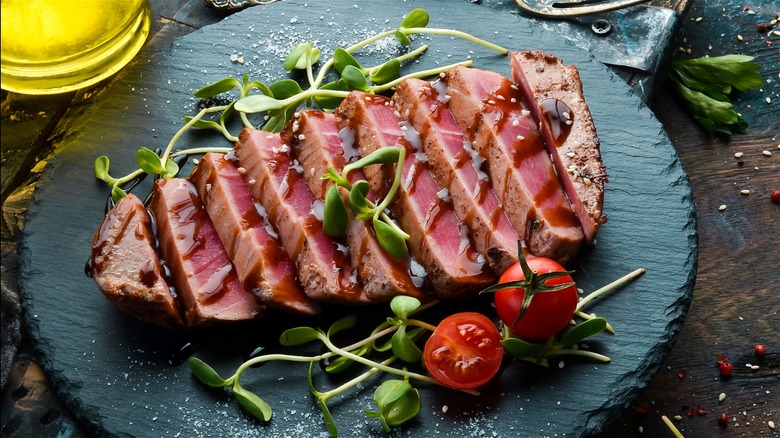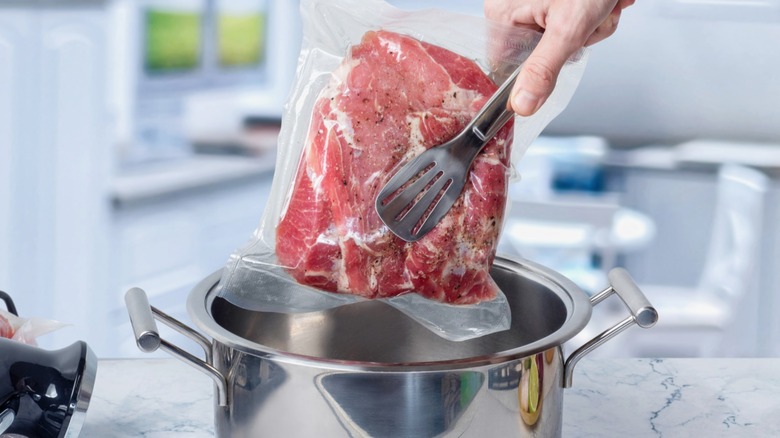Achieve The Perfect Cook For Tuna Steaks With The Sous Vide Technique
Most commonly packed in tins with water or oil, tuna has a reputation for being a fish of convenience. While tuna salad is an easy snack or filling for a sandwich, skip the can next time and grab whole tuna steaks from the seafood market. You can use it to craft a main course that will impress friends and family — like a tuna poke bowl, or sous vide ahi tuna steaks with wasabi cream.
Sous vide has become a popular cooking method for many cuts of beef, and it also works handily with tuna steaks. The process starts with sealing your cut of tuna in an air-tight resealable plastic bag, then, using an immersion circulator, letting it gently cook in a bath of moving hot water. For a tuna steak, depending on the thickness and preferred doneness, 30 to 45 minutes will do the trick. Though this is significantly longer than grilling or pan-searing, the result will prove why this method is perfect for tuna steaks. Sous vide may seem overwhelming if you've never tried it, but is easy to achieve a perfectly cooked cut of fish with this French technique.
Why sous vide is the perfect method for tuna
The term sous vide translates to "under vacuum," an apt description of the method. The trick of sous vide is that it cooks at a gentle, precise temperature for an extended period — allowing your food to reach perfection, with essentially no risk of overcooking. This strategy works especially well for tuna for one big reason. Tuna is a delicate fish that is very prone to overcooking, and this particular technique mitigates the risk of overcooking, making it almost foolproof to put together a restaurant-worthy meal.
While the FDA recommends cooking most seafood to an internal temperature of 145 degrees Fahrenheit to lower your risk of foodborne illness, when it comes to delicate tuna steaks you'd be hard-pressed to find a sous vide recipe suggesting higher than 120 degrees. For culinary perfection, cooking tuna steak sous vide at 110 degrees for 45 minutes is best. Tuna steak ideally should be served rare, and this temperature is perfect for achieving a rare tuna steak that's reached 110 degrees in the center. It's then ready to be quickly seared in the final step. To keep the deliciously moist, bright pink center, your immersion circulator will be your best friend.
Sous vide tricks of the trade
Sous vide certainly lends well to cooking a tuna steak, but to assume the same rules apply to all raw proteins would be a mistake. For one, most recipes call for tuna to be cooked at a much lower temperature than most kinds of meat. Chicken needs to be cooked at 165 degrees Fahrenheit, no matter what, for food safety reasons. And, since tuna is so delicate, it's recommended to use the water displacement method when sealing it into a plastic bag. Other, heartier meats usually get vacuum-sealed — a method that puts more pressure on the protein.
Since tuna is so soft, it can become malformed from the force of the vacuum sealer. To employ the water displacement method all you need is an ordinary resealable bag. Once brined or seasoned, place your tuna inside the bag and zip it almost all the way closed. Then, lower the bag into a pot of water and the pressure will push the remaining air out of the opening in the bag. This will preserve the shape of the tuna while keeping it safely sealed. Then you can throw it in the circulating hot water bath, and 45 minutes later it's ready for that quick sear (about 30 seconds per side). Then slice it and plate it beautifully with the sauce and sides of your choice.


